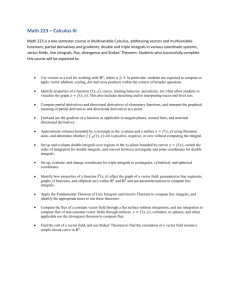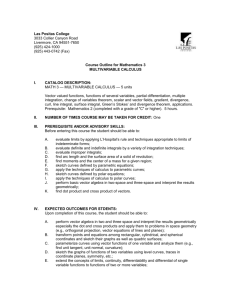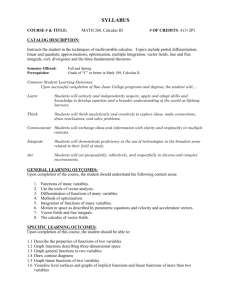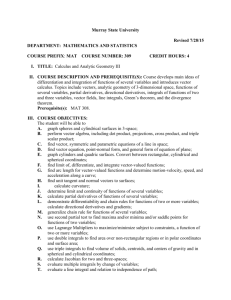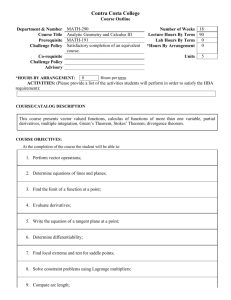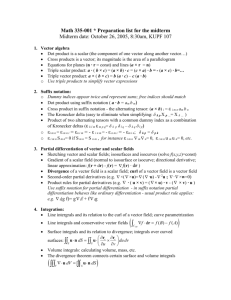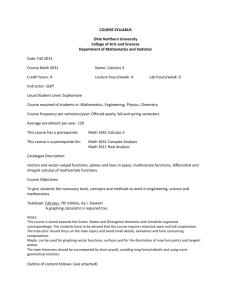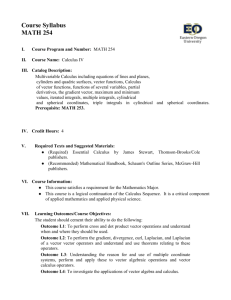Multivariable Calculus
advertisement
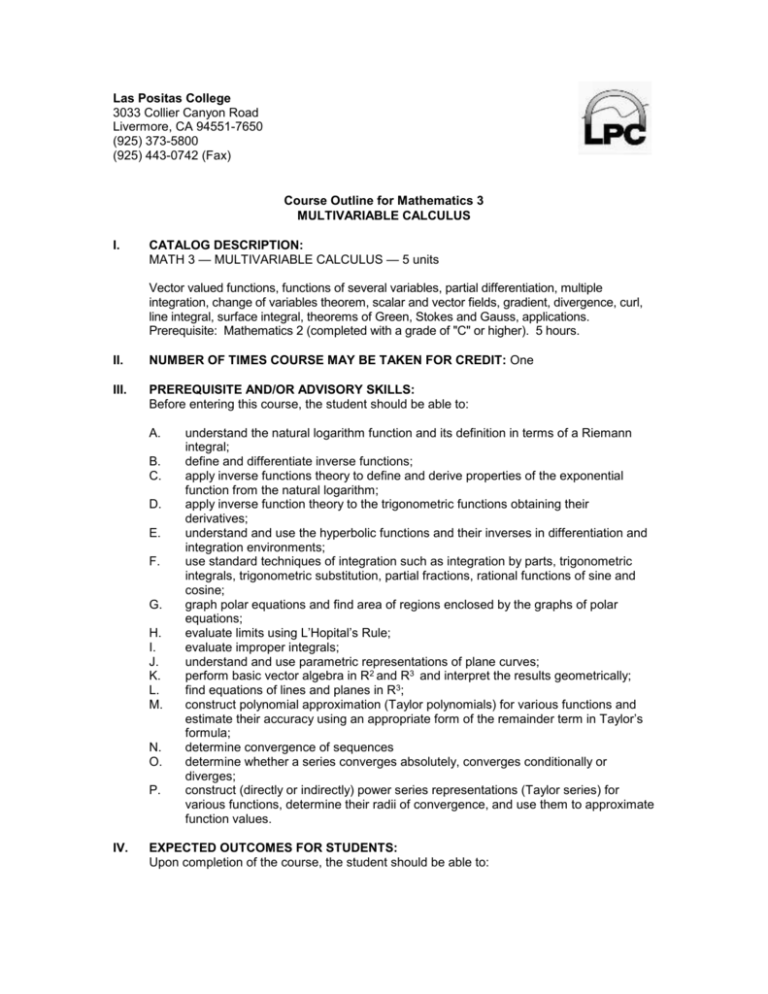
Las Positas College 3033 Collier Canyon Road Livermore, CA 94551-7650 (925) 373-5800 (925) 443-0742 (Fax) Course Outline for Mathematics 3 MULTIVARIABLE CALCULUS I. CATALOG DESCRIPTION: MATH 3 — MULTIVARIABLE CALCULUS — 5 units Vector valued functions, functions of several variables, partial differentiation, multiple integration, change of variables theorem, scalar and vector fields, gradient, divergence, curl, line integral, surface integral, theorems of Green, Stokes and Gauss, applications. Prerequisite: Mathematics 2 (completed with a grade of "C" or higher). 5 hours. II. NUMBER OF TIMES COURSE MAY BE TAKEN FOR CREDIT: One III. PREREQUISITE AND/OR ADVISORY SKILLS: Before entering this course, the student should be able to: A. B. C. D. E. F. G. H. I. J. K. L. M. N. O. P. IV. understand the natural logarithm function and its definition in terms of a Riemann integral; define and differentiate inverse functions; apply inverse functions theory to define and derive properties of the exponential function from the natural logarithm; apply inverse function theory to the trigonometric functions obtaining their derivatives; understand and use the hyperbolic functions and their inverses in differentiation and integration environments; use standard techniques of integration such as integration by parts, trigonometric integrals, trigonometric substitution, partial fractions, rational functions of sine and cosine; graph polar equations and find area of regions enclosed by the graphs of polar equations; evaluate limits using L’Hopital’s Rule; evaluate improper integrals; understand and use parametric representations of plane curves; perform basic vector algebra in R2 and R3 and interpret the results geometrically; find equations of lines and planes in R3; construct polynomial approximation (Taylor polynomials) for various functions and estimate their accuracy using an appropriate form of the remainder term in Taylor’s formula; determine convergence of sequences determine whether a series converges absolutely, converges conditionally or diverges; construct (directly or indirectly) power series representations (Taylor series) for various functions, determine their radii of convergence, and use them to approximate function values. EXPECTED OUTCOMES FOR STUDENTS: Upon completion of the course, the student should be able to: Course Outline for Mathematics 3 Page 2 MULTIVARIABLE CALCULUS A. B. C. D. E. F. G. H. I. J. K. L. M. N. V. perform vector algebra in R3, interpret the results geometrically especially the dot and cross products and apply them to problems in space geometry (e.g., orthogonal projection, vector equations of lines and planes); transform points and equations among rectangular, cylindrical, and spherical coordinates and sketch their graphs as well as quadric surfaces; parametrize curves using vector functions of one variable and analyze them (e.g., find unit tangent, unit normal, curvature); sketch the graphs of functions of two variables using level curves, traces in coordinate planes, symmetry, etc.; extend the concepts of limits, continuity, differentiability and differential of single variable functions to functions of two variables; compute limits, partial derivatives, total differential, gradient, directional derivatives and interpret them geometrically and in terms of rate of change; apply partial derivatives and/or gradients to problems involving tangent planes and linear approximation, and optimization, especially using Lagrange multipliers; compute double and triple integrals directly or using change of variables and explain the geometric interpretation of Jacobians; apply differential operators gradient, divergence, curl and Laplacian to scalar and vector field and interpret the results; compute line integrals using parametrizations for curves; parametrize surfaces using vector functions of two variables, and compute their areas; compute surface integrals of scalar functions and vector functions using parametrization for surfaces; interpret the theorems of Green, Stokes and Gauss physically as well as mathematically (as the generalizations of the Fundamental Theorem of Calculus), and use them to compute line and surface integrals; find scalar potentials for conservative vector field. CONTENT: A. Space Analytic Geometry 1. rectangular, cylindrical and spherical coordinate systems 2. surfaces (cylinders, quadric surfaces and surfaces of revolution) 3. vector algebra and geometry in R3 especially dot and cross product, lines and planes 4. vector functions and parametrized curves B. Partial Differentiation 1. scalar functions of two or more variables 2. limits, continuity, partial derivatives, Chain Rule 3. tangent planes and linear approximation 4. optimization (especially using Lagrange multipliers) C. Multiple Integration 1. double and triple integrals and their evaluations in rectangular, polar, cylindrical and spherical coordinates 2. change of variables and Jacobians 3. area, volume, surface area, center of mass and moments of inertial D. Scalar and Vector Fields 1. scalar and vector fields 2. vector differential operators (gradient, divergence, curl and Laplacian) and indentities involving them E. Integrals over Paths and Surfaces 1. integral of scalar functions along a path and line integrals 2. path independence 3. parametrized surface and its area 4. surface integral F. Vector Analysis 1. Green’s and Stokes’ Theorems Page 3 Course Outline for Mathematics 3 MULTIVARIABLE CALCULUS 2. 3. scalar potentials and conservative fields Gauss’ Theorem VI. METHODS OF INSTRUCTION: A. Lecture with computer or graphing calculator demonstrations B. Classroom discussion C. Collaborative learning where applicable VII. TYPICAL ASSIGNMENTS: A. Textbook assignments 1. Section 15.1 Problems 5, 7, 11, 15, 17, 19, 21, 23 (partial derivatives) 2. Section 14.3 5019 odd, 23-29 odd, 39 (vector values functions). B. Typical collaborative activity 1. Suppose Howard Ant is walking on the xy-plane in such a way that at time t=0 he is at the origin while at an arbitrary time t his position is given by the vector s (t ) x(t )i y (t ) j . Determine s (t ) if Howard’s velocity is given by t v (t ) (cos t )i e j . VIII. EVALUATION: A. Methods 1. Examinations 2. Announced and unannounced quizzes 3. Homework 4. Final exam B. Frequency of evaluation 1. Recommend 3 or 4 exams plus a final examination C. Types of problems 1. Find the radius of curvature of y cos x at x 0 and x . Sketch the osculating circles at these points 2. Show that the limit x2 y does not exist lim ( x , y ) ( 0, 0 ) 2 y 3 2 y 3 IX. TYPICAL TEXTS: A. Anton, Calculus-A New Horizon, 6th Edition. John Wiley and Sons, 1999. B. Marsden, Tromba, Weinstein, Basic Multivariable Calculus, Freeman Publisher, 1993. C. Stewart, Calculus, 4th Edition. Brooks/Cole, 1999. X. OTHER MATERIALS REQUIRED OF STUDENTS: A scientific or graphing calculator may be required. Creation Date: Revision Date: 1/94, 2/95, 3/00 math3
